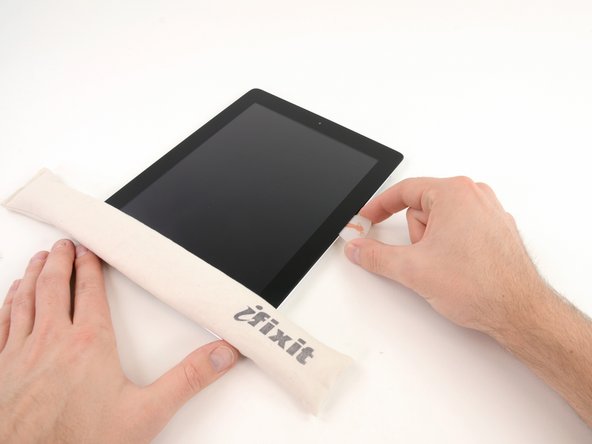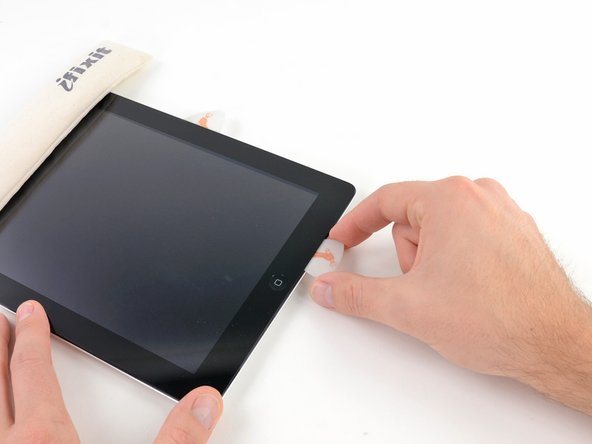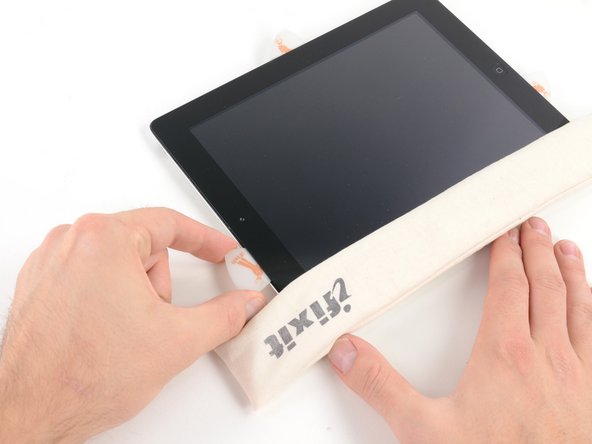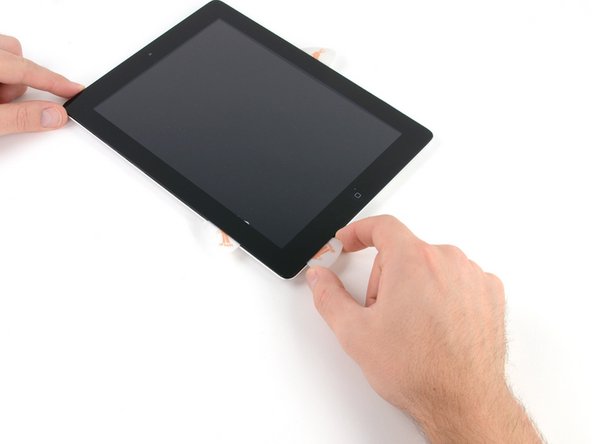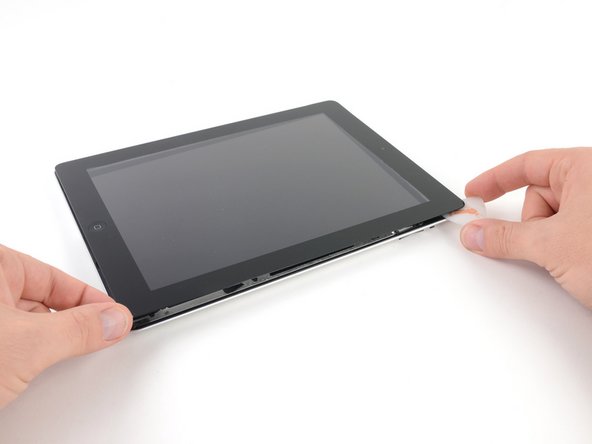DIY iPad Wi-Fi Rear Facing Camera Replacement Guide
Duration: 45 minutes
Steps: 54 Steps
Heads up! Before you dive into this repair adventure, make sure you’re in a cozy spot with good lighting and all your tools ready to roll. If you hit a snag or feel overwhelmed, remember, there’s no shame in asking for help. You can always schedule a repair and let the pros take care of it!
Ready to give your rear-facing camera a new lease on life? This guide will walk you through the steps to make that happen. Let’s get started and bring your camera back into focus!
Step 1
Before diving in, give your microwave a quick clean-up! Any stubborn mess down there might just hitch a ride on the iOpener, and nobody wants that.
– Pop the iOpener right in the middle of the microwave like it’s the star of the show!
Tools Used
Step 2
Take it easy with the iOpener during your repair journey! Overheating can lead to a surprise burst, and we definitely don’t want that. Keep it under 100˚C (212˚F) for safety’s sake!
If the iOpener looks a bit puffy, steer clear of it. Safety first!
If the center of the iOpener feels too hot to handle, keep using it and let it chill for a bit before you reheat. A well-heated iOpener should remain cozy for up to 10 minutes.
– Give your iOpener a cozy thirty-second spa session in the microwave.
– As you work your magic on the repair, keep the iOpener nice and warm by giving it another thirty seconds in the microwave whenever it starts to cool down.
Tools Used
Step 3
Heads up! The iOpener is going to be pretty toasty, so handle it with care. An oven mitt might come in handy here!
– Carefully take the iOpener out of the microwave, making sure to grab it by one of the flat ends to steer clear of that hot center. Safety first, right?
Tools Used
Step 4
If you don’t have a microwave handy, no worries! Just follow this step to warm up your iOpener using some good old boiling water.
– Grab a pot or pan and fill it up with enough water to give your iOpener a nice, warm bath.
– Bring that water to a rolling boil and then turn off the heat—safety first!
– Carefully drop your iOpener into the hot water and let it chill there for 2-3 minutes, ensuring it’s fully submerged. It’s like a mini spa day for your tool!
– Using tongs (because nobody wants to burn their fingers), take the iOpener out of the hot water.
– Give your iOpener a good dry-off with a towel—it’s all about that nice finish.
– And just like that, your iOpener is ready to rock! If it needs a little more heat later on, just repeat the water boiling dance for another 2-3 minutes.
Tools Used
Step 5
Put on those safety glasses to keep your peepers protected, and remember to treat that LCD screen like the precious gem it is!
– If your screen is sporting a crack, let’s keep things safe and sound! Grab some tape and cover that glass to avoid any further mishaps during your repair adventure.
– Lay down some overlapping strips of clear packing tape over the iPad’s screen until it’s completely covered. It’s like giving your device a protective blanket!
– Try your best to stick to the guide as we go along. But hey, once the glass starts to crack, it might just want to keep on cracking while you work. You might need to get a metal prying tool to scoop out those pesky shards.
Step 6
Just a quick heads-up! As you dive into this repair adventure, keep in mind that you might be dealing with some sharp glass bits. So, grab those safety glasses to keep your peepers safe from any sneaky shards that might fly your way. Better safe than sorry, right?
– Place the iOpener snugly on the right edge of the iPad, ensuring it’s making good contact with the surface. Give it a little love tap to smooth it out!
– Let that bag chill on the iPad for about 90 seconds. This will warm things up nicely before you dive into opening the front panel.
Tools Used
Step 7
Getting that wedged tip of the opening tool between the glass and plastic might take a little muscle. No worries! Just take your time and gently wiggle the tool back and forth as needed. You’ve got this!
– Hey there! So, there’s a little sneaky gap in the adhesive ring of your iPad, hanging out in the upper right corner, about 2.0 inches (~5 cm) from the top. Time to take advantage of this little flaw!
– Now, grab your tool and line it up with the mute button. Carefully slide the tip of a plastic opening tool into that gap between the front glass and the plastic bezel. Just poke the very tip in there, just enough to give that crack a little stretch!
Step 9
– With the tip of your trusty plastic opening tool snugly nestled between the front glass and the plastic bezel, gently slide a plastic opening pick into that delightful little gap right beside the tool. You’ve got this!
Step 10
– Take out the plastic opening tool from your iPad, and slide the opening pick a bit deeper under the front glass, aiming for about 0.5 inches. You’re doing great!
Step 12
The adhesive is super strong, so you might need to put in some elbow grease. Just take it slow and steady!
If you spot the tip of the opening pick peeking out from under the front glass, gently pull it out a tad. While it’s all good to use the pick at this depth without causing any harm, just a heads-up: it might leave some adhesive residue on the LCD. No biggie, though!
– As the iOpener works its magic on the bottom edge, let’s start loosening up that pesky adhesive on the right edge of the iPad.
– Gently slide the opening pick down along the iPad’s edge, peeling away the adhesive as you glide. You’ve got this!
Tools Used
Step 13
As you peel away that sticky adhesive, you might find it helpful to slide the warm iOpener back to the right edge of the iPad. This little move can make a difference, especially if your iPad has had some time to chill while you were getting your repair groove on.
– If the opening pick gets a bit cozy with the adhesive, just give it a gentle ‘roll’ along the edge of the iPad to keep freeing up that sticky stuff.
Tools Used
Step 14
– Before you dive into opening up your iPad, slide a second pick under the right edge of the front glass to keep that pesky adhesive from sticking back together. Trust us, it’ll make your life easier!
– Give your iOpener a little re-heat love, and then place it at the top edge of the iPad. We’re almost there!
Tools Used
Step 15
Hey there! Just a heads up: the Wi-Fi antenna is snugly fastened to the bottom right corner of the iPad’s rear case with screws and a cable. Since the Wi-Fi antenna has a specific orientation, it’s super important to handle it with care to avoid any accidental mishaps that could lead to permanent damage. You’ve got this!
– Alright, folks! Time to tread lightly for the next few steps.
– You’ll need to gently peel back the adhesive holding the antenna to the front panel. Just be super careful not to harm those delicate bits that connect the antenna to the bottom of the iPad. Follow along closely, and you’ve got this!
Step 16
Keep that pick away from the bottom right corner! Going too far could put a dent in your Wi-Fi antenna, and we definitely don’t want that.
– Gently glide that opening pick around the bottom right corner of your iPad to free up the adhesive like a pro!
Step 17
Take your time and gently slide the opening pick along the bottom right edge of the front panel. Be careful around the corner where the Wi-Fi antenna is located—it’s a bit of a tight squeeze, and if the adhesive isn’t released just right, you might accidentally snip that connection!
Keep that pick snugly under the front glass—just a little peek is all you need! Pull it out just enough so that about 1/8″ (3 mm) of the tip is still hiding underneath the glass.
– Gently slide the tip of the opening pick along the bottom edge of your iPad to set the Wi-Fi antenna free from its adhesive hold. You’ve got this!
Step 18
– After you’ve gracefully glided past the Wi-Fi antenna (that’s about 3 inches or 75 mm from the right edge, right near the home button), pop that opening pick back in all the way.
– Now, slide that pick to the right and watch as the adhesive holding the Wi-Fi antenna to the front glass gives way. Easy peasy!
Step 19
Keep the iOpener’s heat game strong, but don’t go over a minute at a time. Remember to give it a little break of at least two minutes before you heat it up again!
– Keep gently peeling away the adhesive at the bottom of your iPad, making sure to pull the opening pick out far enough to navigate around the home button. Once you’ve bypassed the button, reinsert the pick to a depth of about 1/2 inch (10 mm). You’ve got this!
Tools Used
Step 20
– Keep on peeling that adhesive all along the bottom edge of the iPad like a pro!
– Once you’re in, leave that opening pick snugly tucked under the front glass close to the home button.
Step 22
If your adhesive has decided to take a little too much time cooling off, just pop the iOpener back along the top edge and keep at it! And if the iOpener is feeling a bit chilly, give it a warm-up before you dive back in.
– Gently slide the opening pick along the top edge of your iPad, giving it a little tug to navigate around the front-facing camera bracket.
– This section has some seriously thick adhesive, so you might need to put in a bit of effort. Take your time and be cautious, making sure not to slip and cause any mishaps with yourself or your iPad.
– If the opening pick feels like it’s stuck in the adhesive, try rolling it as demonstrated in step 9.
Tools Used
Step 23
If the adhesive is feeling nice and toasty, go ahead and take the iOpener off your iPad for easier handling. But if it’s still hanging on tight, just give the iOpener another heat-up and set it on the left edge while you get to work.
– Keep peeling away the adhesive at the top edge of your iPad, and gently slide that opening pick around the top left corner like you’re dancing with it.
Tools Used
Step 24
The digitizer cable is hanging out about 2 inches (50 mm) from the bottom of the iPad. When you’re about 2.25 inches (60 mm) from the bottom, it’s time to pause the pick action—let’s keep that cable safe and sound!
– Gently glide the opening pick along the left edge of your iPad, letting it work its magic on the adhesive as you move. The adhesive is a bit shy here because of the digitizer that runs along the entire left side. Just be careful not to go too deep—stick to a depth of about 1/2 inch (10 mm) to keep that digitizer safe and sound!
Step 25
Be super careful with the digitizer cable—it’s just about an inch (25 mm) from the bottom of your iPad! Take your time and work gently to avoid cutting this little guy. You’ve got this!
– With the opening pick still nestled under the bottom edge of your iPad, gently pry to break the adhesive seal at the bottom left corner.
Step 26
– Grab one of those handy opening picks and gently nudge the bottom right corner of the iPad. Once it’s popped up, give it a little pinch with your fingers to keep it open!
Step 27
Watch out for any sticky adhesive that might still be clinging on! Grab an opening pick and gently slice through any stubborn adhesive that’s keeping the front panel in place.
– Grab your iPad by the top and bottom right corners and gently twist the front glass away from the device. It’s like giving your iPad a little stretch!
– When you’re putting everything back together, take a moment to use a microfiber cloth and some compressed air to wipe away any dust or fingerprints on the LCD. A clean screen is a happy screen!
Step 28
The bottom left screw is hiding behind the home button ribbon cable connector. Gently nudge the ribbon cable aside to free that pesky screw from its hiding spot.
– Let’s get this party started by unscrewing the four 2 mm Phillips #00 screws that are holding the LCD tight to the aluminum frame. You’ve got this!
Step 29
Handle the LCD with care! That ribbon cable is as delicate as a butterfly and could snap if it gets bent too much. Keep it cool and steady!
– Grab a trusty plastic opening tool or a spudger, and gently lift the right edge of the LCD out of the iPad. You’re doing great!
– Now, swing that LCD around along its left edge and set it down carefully on top of the front glass panel. Almost there!
Tools Used
Step 30
– With the spudger’s tip, gently lift the tape that’s keeping the LCD ribbon cable connector snug. You’ve got this!
Tools Used
Step 31
– Gently lift the retaining flap on the LCD ribbon cable ZIF connector.
– With a little finesse, use your fingers or a pair of tweezers to slide the LCD ribbon cable out of its cozy spot on the logic board.
Tools Used
Step 32
– Carefully lift the LCD off the front panel without touching its surface. You’ve got this!
Step 33
If it’s there, go ahead and peel off that little piece of electrical tape covering the Wi-Fi antenna, speaker cable, and home button ribbon cable. You’ve got this!
Step 34
– Lift the little flap on the home button ribbon cable ZIF connector up and away like you’re unveiling a surprise!
Step 35
– Grab a trusty pair of tweezers and gently pull that home button ribbon cable straight out of its cozy socket on the logic board. You’ve got this!
Tools Used
Step 36
– Carefully guide the home button ribbon cable out of its snug little home in the rear case.
Step 37
– Grab a trusty pair of tweezers and gently lift the tape that’s holding down the digitizer ribbon cable to the logic board. You’ve got this!
Tools Used
Step 39
– Grab your trusty spudger and gently pry up the adhesive holding down the digitizer ribbon cable. It’s like giving it a little nudge!
– Once you’ve loosened it up, carefully pull the digitizer ribbon cable straight out from its cozy spot on the logic board. Easy peasy!
Tools Used
Step 40
– Gently lift the digitizer ribbon cable and grab your trusty spudger to carefully detach the adhesive that’s holding the cable to the rear aluminum case. You’ve got this!
Tools Used
Step 41
– With a gentle touch, carefully pull the digitizer ribbon cable out from its cozy spot in the aluminum frame. You’ve got this!
– Now, let’s remove the front panel from the iPad and reveal the magic inside. Take your time and enjoy the process!
Step 42
– Grab your trusty tweezers and gently peel back that pesky piece of electrical tape that’s hiding the headphone jack assembly cable connector. It’s like unwrapping a little surprise!
– Next up, take the tip of a spudger and flip up the retaining flap on both ZIF connectors that are holding the headphone jack cable to the logic board. It’s a delicate dance, but you’ve got this!
Step 43
– Gently ease the flat end of your trusty spudger under the headphone jack assembly cable, giving a little nudge to release the adhesive that’s keeping it cozy with the rear aluminum frame.
– Now, with a steady hand, pull the headphone jack assembly cable straight out of its snug socket on the logic board. You’re doing great!
Tools Used
Step 44
– Gently nudge the front-facing camera ribbon cable aside using the flat edge of a spudger, but remember, no need to take it out completely!
Tools Used
Step 45
– Gently peel away the sticky tape that’s holding down the headphone jack assembly. You’ve got this!
Step 47
– Gently slide the tip of the spudger under the microphone ribbon cable and nudge it out of its cozy home on the ZIF connector.
– Take the flat edge of the spudger and gracefully shift the microphone ribbon cable to the side.
Tools Used
Step 48
– Gently lift the retaining flap that holds the volume/power button ribbon cable connector in place on the headphone jack assembly board. You’ve got this!
Step 49
– Gently nudge the volume button ribbon cable out of its ZIF connector.
– Carefully bend the volume button ribbon cable upwards to set it aside.
Step 51
– With a gentle grip on the ribbon cable of the headphone jack assembly, lift the assembly upwards towards the top of your device with care.
Step 52
– With one hand, gently hold the headphone jack assembly and carefully pull it away from the iPad, being cautious of any cables that might get snagged along the way.
Step 53
– Grab your trusty spudger and gently wiggle the flat end underneath the rear-facing camera. Give it a little nudge to pop it out of its cozy spot on the underside of the headphone jack assembly board. You’re doing great!
Tools Used
Step 54
– Keep that rear-facing camera in place!
























